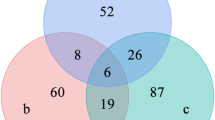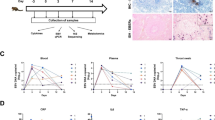Abstract
In Coxsackievirus B3 (CB3) infection, the heart and pancreas are major target organs and, as a general host response, an associated immune activation and acute phase reaction develops. Although iron (Fe), copper (Cu), and zinc (Zn) are involved in these responses, sequential trace element changes in different target organs of infection have not been studied to date. In the present study, Fe, Cu, and Zn were measured through inductively coupled plasma mass spectrometry (ICP-MS) in the plasma, liver, spleen, heart, and pancreas during the early phase (d 1 and 3) of CB3 infection in female Balb / c mice. The severity of the infection was assessed through clinical signs of disease and histopathology of the heart and pancreas, including staining of CD4 and CD8 cells in the pancreas. During infection, the concentrations of Fe, Cu, and Zn changed in the plasma, liver, and pancreas, but not in the spleen and heart. The changes in plasma Cu, Zn, and Fe seemed to be biphasic with a decrease at d 1 that turned into increased levels by d 3. Cu showed similar biphasic changes in the liver, spleen, and pancreas, whereas, for Zn and Fe, this pattern was only evident in the liver. In the pancreas, the reverse response occurred with pronounced decreases in Fe (23%, p<0.05) and Zn (64%, p<0.01) at d 3. Although the pathophysiological interpretation of these findings requires further research, the sequential determination of these elements may be of clinical value in enterovirus infections in deciding the stage of disease development.
Similar content being viewed by others
References
W. R. Beisel, R. S. Pekarek, and R. W. Wannemacher, Jr., The impact of infectious diseases on trace element metabolism in the host, in Trace Element Metabolism in Animals, G. Hoekstra, H. E. Gauther, and W. Mertz, eds., University Park Press, Baltimore, MD, pp. 217–240 (1974).
W. R. Beisel, Metabolic response of the host to infections, in Textbook of Pediatric Infectious Disease, R. D. Feigin, and J. D. Cherry, eds., WB Saunders, Philadelphia, PA, pp. 54–69 (1998).
G. Friman and N.-G. Ilbäck, Acute infection: metabolic responses, effects on performance, interaction with exercise, and myocarditis. Int. J. Sports Med. 19, 1–11 (1998).
S. Cunningham-Rundles, Zinc modulation of immune function: specificity and mechanism of interaction. J. Lab. Clin. Med. 128, 9–11 (1991).
P. J. Fraker, P. DePasquale-Jardieu, C. M. Zwickl, and R. W. Luecke, Regeneration of T-helper cell functions in zinc deficient adult mice. Proc. Natl. Acad. Sci. USA 75, 5660–5664 (1978).
E. Funseth, U. Lindh, G. Friman, and N.-G. Ilbäck, Relation between trace element levels in plasma and myocardium during coxsackievirus B3 myocarditis in the mouse. Bio-Metals 13, 361–367 (2000).
N.-G. Ilbäck, J. Fohlman, and G. Friman, The protective effect of selenium on the development of coxsackievirus B3 induced inflammatory lesions in the murine myocardium. J. Trace Elem. Exp. Med. 2, 257–266 (1989).
N.-G. Ilbäck, J. Fohlman, and G. Friman, Effects of selenium supplementation on virus-induced inflammatory heart disease. Biol. Trace Elem. Res. 63, 51–66 (1998).
M. A. Beck, P. C. Kolbeck, Q. Shi, C. V. Morris, and O. A. Levander, Increased virulence of a human enterovirus (coxsackievirus B3) in selenium-deficient mice. J. Infect. Dis. 170, 351–357 (1994).
J. P. Vartiainen, M. Sala, M. Henry, S. Wain-Hobson, and A. Meyerhaus, Manganese cations increase the mutation rate of human immunodeficiency virus type 1 ex vivo. J. Gen. Virol. 80, 1983–1986 (1999).
N.-G. Ilbäck, G. Friman, and W. R. Beisel, Biochemical responses of the myocardium and red skeletal muscle to Salmonella typhimurim in the rat. Clin. Physiol. 3, 551–563 (1983).
A. Shenkin, Trace elements and inflammatory response: implications for nutritional support. Nutrition 11, 100–105 (1995).
J. F. Woodruff, Viral Myocarditis. A review. Am. J. Pathol. 101, 424–479 (1980).
T. Hyypiä, M. Kallajoki, and P. Auvinen, Detection and typing of enteroviruses by nucleic acid probes and monoclonal antibodies, in New Concept in Viral Heart Disease, H. P. Schultheiss, ed., Springer Verlag, New York, pp. 115–124 (1988).
N.-G. Ilbäck, A. Mohammed, J. Fohlman, and G. Friman, Cardiovascular lipid accumulation with coxsackie B virus infection in mice. Am. J. Pathol. 136, 159–167 (1990).
V. Kytö, A. Saraste, J. Fohlman, et al., Cardiomyocyte apoptosis after antiviral WIN 54954 treatment in murine coxsackievirus B3 myocarditis. Scand. Cardiovasc. Res. 36, 187–192 (2002).
S. A. Huber, Animal models: immunological aspects, in Viral Infections of the Heart, J. E. Banatvala, ed., Hodder & Stoughton, London, pp. 82–109 (1993).
N.-G. Ilbäck, J. Fohlman, S. Slorach, and G. Friman, Effects of the immunomodulator LS 2616 on lymphocyte subpopulations in murine coxsackievirus B3 myocarditis. J. Immunol. 142, 3225–3228 (1989).
J. Fohlman, K. Pauksen, T. Hyypiä, G. Hyypiä et al., Antiviral treatment with WIN 54 954 reduces mortality in murine coxsackievirus B3 myocarditis. Circulation 94, 2254–2259 (1996).
J. F. Woodruff and E. D. Kilbourne, The influence of quantitated post weaning undernutrition in coxsackievirus B3-infection of adult mice. I. Viral persistence and increased severity of lesions. J. Infect. Dis. 121, 137–163 (1970).
G. Friman, N.-G. Ilbäck, and W. R. Beisel, The effect of strenuous exercise on infection with Francisella tularensis in rats. J. Infect. Dis. 145, 706–714 (1982).
N.-G. Ilbäck, G. Friman, D. J. Crawford, and H. A. Neufeld, Effects of training on metabolic responses and performance capacity in Streptococcus pneumoniae infected rats. Med. Sci. Sports Exerc. 23, 422–427 (1991).
S. Pekarek and J. A. Engelhardt, Infection-induced alterations in trace metal metabolism: Relationship to organism virulence and host defense, in Infection: The Physiologic and Metabolic Responses of the Host, R. S. Pekarek and J. A. Engelhardt, eds., Biomedical Press, Elsevier/North Holland, pp. 131–146 (1981).
C. Driessen, H. Hirv, and L. Rich, Zinc regulates cytokine induction by superantigens and lipopolysaccharide. Immunology 84, 272–277 (1995).
G. Fernandes, M. Nair, K. Onoe, T. Tanaka, R. Floyd, and R. A. Good, Impairment of cell-mediated immunity functions by dietary zinc deficiency in mice. Proc. Natl. Acad. Sci. USA 76, 457–461 (1979).
S. S. Percival, Copper and immunity. Am. J. Clin. Nutr. 67, 1064–1068 (1998).
C. Nyström-Rosander, S. Thelin, E. Hjelm, O. Lindqvist, C. Påhlson, and G. Friman, High incidence of Chlamydia pneumoniae in sclerotic heart valves of patients undergoing aortic valve replacement. Scand. J. Infect. Dis. 29, 361–365 (1997).
J. L. Sullivan and E. D. Weinberg, Iron and the Role of Chlamydia pneumoniae in heart disease. Emerg. Infect. Dis. 5, 724–726 (1999).
J. A. Fernandes-Pol, P. D. Hamilton, and D. J. Klos, Essential viral and cellular zinc and iron containing metalloproteins as targets for novel antiviral and anticancer agents: Implications for prevention and therapy of viral diseases and cancer. Anticancer Research 21, 931–958 (2001).
R. Milanino, M. Marrella, R. Gasperini, M. Pasqualicchio, and G. Velo, Copper and zinc body levels in inflammation: an overview of the data obtained from animal and human studies. Agents and Action 39, 195–209 (1993).
E. D. Savlov, W. H. Strain, and F. Heugin, Radio zinc studies in experimental wound healing. J. Surg. Res. 2, 209–212 (1962).
A. S. Prasad, J. T. Fitzgerald, B. Bao, F. W. J. Beck, and P. H. Chandrasekar, Duration of symptoms and cytokine plasma levels in patients with the common cold treated with zinc acetate. Ann. Intern. Med. 133, 245–252 (2000).
P. Z. Sobocinski, W. J. Canterbury, C. A. Mapes, and R. E. Dinterman, Involvement of hepatic metallothioneins in hypozincemia associated with bacterial infection. Am. J. Physiol. 234, E399–406 (1978).
E. Funseth, M. Påhlman, M.-J. Eloranta, G. Friman, and N.-G. Ilbäck. Effects of coxsackievirus B3 infection on the acute-phase protein metallothionein and on cytochrome P450 involved in the detoxification processes of TCDD in the mouse. Sci. Total Environ. 284, 37–47 (2002).
A. Wicklund-Glynn, Y. Lind, E. Funseth, and N.-G. Ilbäck, The intestinal absorption of cadmium increases during a common viral infection (Coxsackievirus B3) in mice. Chem. Biol. Interact. 113, 79–89 (1998).
Author information
Authors and Affiliations
Rights and permissions
About this article
Cite this article
Ilbäck, NG., Benyamin, G., Lindh, U. et al. Sequential changes in Fe, Cu, and Zn in target organs during early coxsackievirus B3 infection in mice. Biol Trace Elem Res 91, 111–123 (2003). https://doi.org/10.1385/BTER:91:2:111
Issue Date:
DOI: https://doi.org/10.1385/BTER:91:2:111




